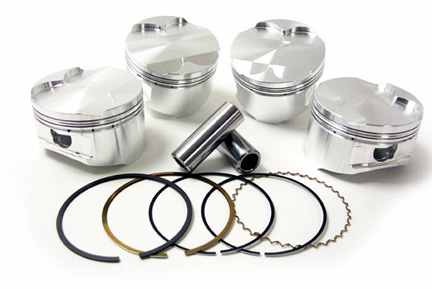Your cart is currently empty!
Piston rings

Piston Rings – Role, Functionality, and Causes of Oil Burning
Piston rings are key components of an internal combustion engine that serve several important functions. Their proper operation is essential for engine efficiency, and wear or damage to piston rings is one of the most common causes of excessive oil consumption. In this article, we will discuss in detail how piston rings work, their functions, and why their wear leads to increased oil consumption.
What Are Piston Rings and What Is Their Role?
Piston rings are metal components fitted into grooves around the circumference of the piston. In a typical internal combustion engine, each piston has three rings:
- Compression Ring (Top)
- Its main task is to seal the combustion chamber to prevent exhaust gases from escaping into the crankcase.
- Transfers heat from the piston to the cylinder walls, helping to cool the engine.
- Compression Ring (Middle)
- Supports combustion chamber sealing.
- Aids in heat dissipation.
- Oil Control Ring (Bottom)
- Its primary function is to scrape excess oil from the cylinder walls and return it to the oil sump.
- Prevents oil from entering the combustion chamber.
How Do Piston Rings Work?
As the engine runs, the piston moves up and down within the cylinder, and piston rings ensure:
- Combustion chamber sealing – prevents exhaust gases from escaping into the crankcase.
- Oil control – the oil ring scrapes excess oil from the cylinder walls, preventing it from entering the combustion chamber.
- Heat transfer – rings help dissipate heat from the piston to the cylinder walls, preventing engine overheating.
Why Do Worn Piston Rings Cause Oil Burning?
Oil burning occurs when engine oil enters the combustion chamber and burns along with the air-fuel mixture. Worn or damaged piston rings are one of the main causes of this phenomenon. Here’s how it happens:
- Loss of Sealing
Worn piston rings lose their ability to effectively seal the combustion chamber. As a result, exhaust gases enter the crankcase, and engine oil can leak into the combustion chamber. - Inadequate Oil Scraping
A worn oil control ring fails to remove excess oil from the cylinder walls. Consequently, oil remains on the cylinder walls and burns with the air-fuel mixture. - Cylinder Wear
Over time, cylinder walls can wear down, making it difficult for the piston rings to create a proper seal. This also allows oil to enter the combustion chamber. - Ring Sticking
In some cases, piston rings can get stuck in the piston grooves due to carbon buildup. Stuck rings lose their flexibility and cannot perform their function, leading to increased oil consumption.
Symptoms of Worn Piston Rings
- Excessive oil consumption – noticeable drop in oil levels between changes.
- Blue smoke from the exhaust – burning oil produces blue smoke, especially during acceleration.
- Loss of engine power – worn piston rings can cause a drop in compression, affecting engine performance.
- Increased crankcase pressure – worn rings allow exhaust gases to enter the crankcase, increasing pressure and potentially damaging seals.
How to Diagnose Piston Ring Issues?
- Compression Test
Measures cylinder pressure. Low pressure may indicate worn piston rings. - Leak-Down Test
Involves injecting air into the cylinder and monitoring pressure loss. A drop in pressure suggests sealing issues due to worn rings. - Exhaust Gas Analysis
The presence of oil in exhaust emissions confirms piston ring wear. - Visual Inspection
A mechanic can remove the cylinder head to inspect the condition of piston rings and cylinders.
Repair Methods
If the problem is caused by worn piston rings, the following steps will be necessary:
- Replacement of piston rings
Replacing piston rings is a complicated procedure that requires engine disassembly. The cost of this repair can range from 700 to even 2500 EUR, depending on the engine model. - Cylinder honing
If the cylinder walls are worn, they may need to be honed (ground) or even replaced. - Cleaning pistons and ring grooves
If the piston rings are seized, it is necessary to thoroughly clean the pistons and grooves from carbon deposits. - Oil and filter replacement
After the repair, the engine oil and filter should be replaced to remove contaminants.
How to Prevent Piston Ring Wear?
- Regular oil changes – use high-quality engine oil and change it according to the manufacturer’s recommendations.
- Avoid engine overheating – overheating can cause piston rings to deform.
- Use proper fuel – low-quality fuel can cause carbon deposits to form.
- Regular engine maintenance – take care of the engine’s technical condition to avoid serious failures.
Conclusion
Piston rings play a crucial role in engine performance. Their wear or damage is a major cause of excessive oil consumption, which can lead to serious engine issues. If you notice symptoms such as blue exhaust smoke, low oil levels, or power loss, consult a mechanic immediately. Replacing piston rings is costly but essential to restore engine efficiency.
